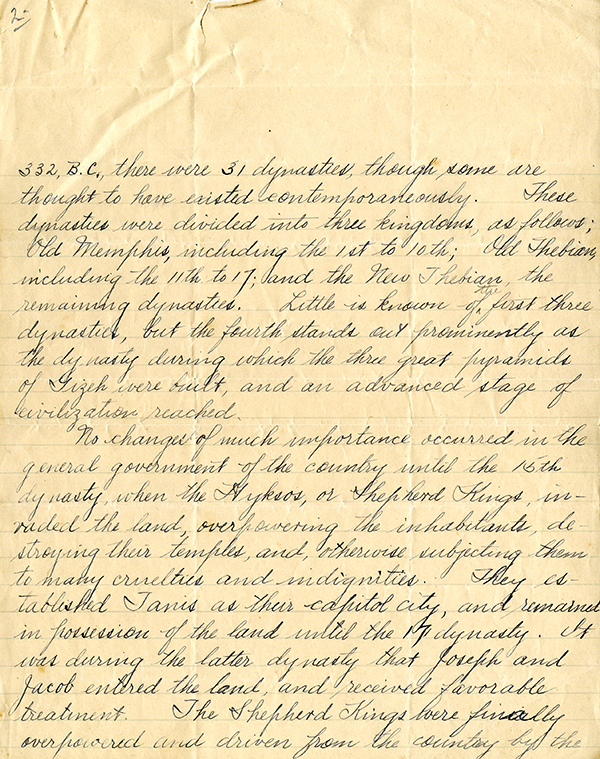Rahn’s First Prize Essay on Egypt, 1907
Series: (Series N2009- 3, Koreshan Unity; Papers, ca. 1887-1990.)
Page 2 of 4
Koreshan Unity

Transcript
The ancient history of Egypt is enveloped in a maze of uncertainty and doubt. She can, however, lay claim to a higher antiquity than any other race. Mythically, her historians refer to a dynasty of gods, as being the first rulers of the land, followed by demi-gods or heroes, who ruled successfully for a period approximating twenty thousand years. This is consider(ed) (added in) an absurd and fabulous claim, but recent knowledge upon the civilizations of antiquity render it plausible and within reason. The first king, of whom we have any record, following this mythical period, is Menes; believed to have been the son of Cham, the 2nd son of Noah. The beginning of his reign is uncertain. Some place it as far back as 5700 B.C.; others at 4400B.C., and less. To him is credited the founding of the city of Memphis, and, also with having corrupted divine worship, inaugurating, instead, the worship of objects in the physical, animal and vegetable worlds. Their three principal deities were: Osiris and Isis, representing the sun or father, and moon or mother, respectively, and their son Horos.
From the reign of Menes until that of Nectanebo II, 332 B.C., there were 31 dynasties, though some are thought to have existed contemporaneously. These dynasties were divided into three kingdoms, as follows; Old Memphis, including the 1st to 10th; Old Thebian, including the 11th to 17; and the New Thebian, the remaining dynasties. Little is known of the first three dynasties, but the fourth stands out prominently as the dynasty during which the three great pyramids of Gizeh were built, and an advanced state of civilization reached.
No changes of much importance occurred in the general government of the country until the 15th dynasty, when the Hyksos, or Shepherd Kings, invaded the land, overpowering the inhabitants, destroying their temples, and, otherwise subjecting them to many cruelties and indignities. They established Tanis as their capitol city, and remained in possession of the land until the 17 dynasty. It was during the latter dynasty that Joseph and Jacob entered the land, and received favorable treatment. The Shepherd Kings were finally overpowered and driven from the country by the Egyptians, under Aahimes, who established the third kingdom, beginning with the 18th dynasty, about 1635 B.C. Under this new era civilization seems to have regained something of its former grandeur. Egypt became one of the greatest powers, and made successful conquests of portions of Asia; conquering Syria and part of Mesopotamia.
During the 19th dynasty, under the rule of Ramesess [sic] II, the conqueror, and best known Pharoah, the height of glory and power was attained. He reigned 65 years, and built many magnificent buildings, doubtless, compelling the Hebrews to build the majority of same. Meneptah II, followed, and is generally regarded as the Pharoah, reigning at the time of the exodus of the Hebrews, about 1320 B.C. Subsequently, Egypt began to decline rapidly, and during the 25th dynasty, about 655 B.C., the land was overrun by the Ethiopians, who in turn were at war, most of the time, with the Assyrians. After a period of fifty years, the Ethiopians voluntarily retired from the country.
For a short space of time Egypt enjoyed freedom from invasion by foes. They welcomed the exiled inhabitants of Jerusalem, who had been conquered by Nebuchadnezzar, King of Babylon. This Babylonian King next invaded and conquered Egypt, about 568 B.C., and Egypt remained a part of the Babylonian Empire until Cambyses, Kind of Persia, over-threw Babylon, and invaded Egypt, reducing the country to the condition of a Persian province.
Egypt, eventually, passed succeedingly under the dominion of Greece, the Romans, and Mohammedans.
“History.”

 Listen: The Assorted Selections Program
Listen: The Assorted Selections Program